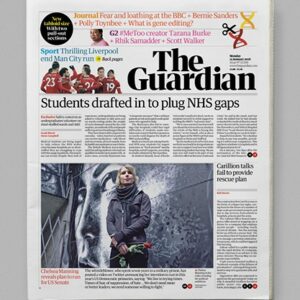The Guardian relaunch underlines insignificance of print
The lack of noise – positive or negative – about the relaunch of the tabloid Guardian last week underlines just how irrelevant print is becoming to the newspaper market.

Of course, it is also true that The Guardian is the last of the broadsheets – other than the Telegraph, which it seems will go to its grave in the larger format – to go tabloid or abandon print altogether. And given the perilous finances of the newspaper’s owners, GMG, this shift has been seen as inevitable after 13 years of the paper’s ruinously costly Berliner format (GMG made losses before exceptional items of £45m on turnover of £214m last year).
But the figures speak for themselves. Only 20% of the people who pay for access to the Guardian’s content buy the newspaper. Last year, the Guardian announced that over 800,000 people now pay for access to its content, through a combination of donations, newsstand sales and mobile subscriptions – but fewer than 150,000 of those buy the print newspaper. Of course, the print product is seen by a claimed additional 720,000 people – who I guess you would classify as free users – but this number itself is only a tiny 2% of the 34.7m non-paying monthly online users.
So, the lack of engagement with print at least for the Guardian reader base is clear. But one piece of good news for GMG is that its revenues are at least starting to reflect its digital future. Of £214.5m total revenue last year, £94.1m is from digital sources (advertising, donations and subscriptions); a healthy 44% share of revenues.
Other than the Independent – whose revenues are obviously all digital – it is reasonably difficult to find similar figures for other broadsheets. But it is clear that the financial landscape is looking increasingly challenging for these ‘serious’ titles.
The Times, which published its accounts last week, avoids the subject of digital revenue, while talking up its digital growth (it now has 171,000 paid subscribers to the digital daily, and 189,000 to the Sunday Times, though this latter number is suspiciously identical to the print subscription base). Across the group, it made a £4m loss last year.
Similarly, the Telegraph Media Group only mentions a 24% increase in digital subscriptions but does not differentiate digital revenues in its latest accounts. Its profits were also down to £36m before exceptional expenses, from over £50m the year before, while revenues dropped from £320m to £295m.
In the year to December 2016, the FT made a loss of £547,000 before taxation, after a profit of almost £700,000 in 2015. With 650,000 paid-for digital subscriptions, the company was nonetheless pleased that over 50% of its revenues came from “digital and services” in that period.
This is the tipping point, of course. As mobile platforms and the apps which deliver the content improve, more and more readers will migrate to digital. ‘Services’ – events, reader offers, and membership operations such as dating sites – though useful, will not cover the loss of print advertising. The Guardian and others will soon be faced with the same decision the Independent faced: at what point do they abandon print and embrace the digital-only future?
enquiries@trippassociates.co.uk
Martin Tripp Associates is a London-based executive search consultancy. While we are best-known for our work in the TMT (technology, media, and telecoms) space, we have also worked with some of the world’s biggest brands on challenging senior positions. Feel free to contact us to discuss any of the issues raised in this blog.
Image from itsnicethat.com